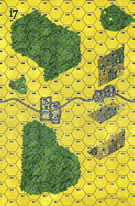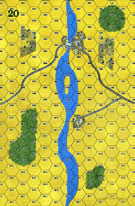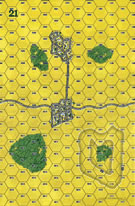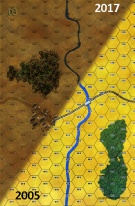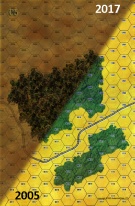|
Falangist Honor Blue Division #3 |
||
|---|---|---|
| (Defender) Spain | vs | Soviet Union (Attacker) |
| Formations Involved | ||
|---|---|---|
| Soviet Union |  |
305th Rifle Division |
| Soviet Union |  |
44th Tank Brigade |
| Spain |  |
269th Infantry Regiment |

|
| Overall Rating, 6 votes |
|---|
|
3.83
|
| Scenario Rank: 175 of 957 |
| Parent Game | Blue Division |
|---|---|
| Historicity | Historical |
| Date | 1941-11-12 |
| Start Time | 00:00 |
| Turn Count | 60 |
| Visibility | Night |
| Counters | 152 |
| Net Morale | 1 |
| Net Initiative | 1 |
| Maps | 6: 15, 17, 20, 21, 3, 6 |
| Layout Dimensions | 86 x 84 cm 34 x 33 in |
| Play Bounty | 183 |
| AAR Bounty | 154 |
| Total Plays | 5 |
| Total AARs | 3 |
| Battle Types |
|---|
| Road Control |
| Urban Assault |
| Conditions |
|---|
| Off-board Artillery |
| Reinforcements |
| Terrain Mods |
| Scenario Requirements & Playability | |
|---|---|
| Blue Division | Base Game |
| Eastern Front | Maps + Counters |
| Road to Berlin | Maps + Counters |
| Introduction |
|---|
|
Three days after relieving a battalion of the German 18th Motorized Division, the Blue Division's 269th Infantry Regiment came under furious assault. The line south of Leningrad had to be held to maintain pressure on the Soviet Union's cultural center. Heavy air and artillery support preceded the waves of infantry backed by tanks that poured across the Vishera River. |
| Conclusion |
|---|
|
Backed by two newly-arrived batteries of 155mm French-made artillery (the awesome weapon known to the U.S. Army as the "Long Tom"), the Spanish gave ground slowly and claimed their morale actually rose as they took casualties. Col. Jose Martinez Esparza sent his regimental cyclist company to the key town of Posad . "I expect," he radioed ahead to 1st Battalion commander Augustin Molinello Luque, "that the Falangist honor of your battalion will be demonstrated by the energetic defense of Posad." Sending his message in clear text, he also claimed he would arrive personally with a full battalion of reserves (reserves he did not possess). The Red Army was not fooled, and continued its assaults until the following afternoon, when the offensive finally shifted to another sector. |
| AFV Rules Pertaining to this Scenario's Order of Battle |
|---|
|
| 2 Errata Items | |
|---|---|

|
The reduced direct fire value in Kursk: Burning Tigers is 4-4. (plloyd1010
on 2015 Jul 31)
|

|
Kommissars never get morale or combat modifiers. Ignore misprints. (Shad
on 2010 Dec 15)
|
| Soviet Masses launch night attack | ||||||||||||
|---|---|---|---|---|---|---|---|---|---|---|---|---|
Scenario 3/20: Falangist Honor – Soviet Masses launch night attackThe main objectives: Soviet 1. Control both main towns by the river. OR 2. Control the northern towns and road. OR 3. Control the southern town and road Spanish 1. Stop the Soviets and inflict casualties. Time = 15 hours (60 turns) Note: Score will be denoted by (x-y), where x=Soviet casualties, y=Spanish casualties. THE BATTLENight, snowing. Snow on the ground. River is frozen. Visibility = 2 hexes. Midnight. Soviet forces arrive in the east a few kms east of the frozen river. They advance en masse where the Spanish wait in northern and southern towns. The Soviets close in. They stay at maximum visibility in the north engaging in direct fire while in the south they move in for assault. Artillery begins to fire from both sides. (3-1) Soviet armour heads towards the Spanish mortar position. Spanish 37mm crews are eliminated. Soviets take huge casualties from close (adjacent) fire and artillery strikes! Just after 0200 and casualty count has leaped, Soviets have already lost 8 full platoons (16-4) Spanish fire and 2 more Soviet platoons are lost in both the north and the south! (24-4). But the Soviets counter attack and Spanish suffer devastating losses of their own losing 1 and a half platoons, 75mm battery and a Captain. Soveit HMGs move into the southern town. Spanish mortars are being overrun by Soviet armour. In the north, Spanish troops are demoralised as their Teniente is killed. They rally but lose morale and men when hit by further artillery. In the south, the sides trade losses, which is not good for the outnumbered Spanish. (27-11) Nearing 0300 and the Spanish are hurting in both towns but continue to inflict casualties. Both sides bolster the assault in the north as one Spanish platoon flees into the nearby woods only to be blown up by Soviet artillery. (34-17) Spanish reinforcements arrive in west. Soviet armour moves north to assist in the assault of the northern town. The Kommissar begins eliminating Soviet troops who fail to rally. In the South, Spanish suffer terrible losses. An infantry platoon is eliminated while a HMG platoon flees town demoralised. Again, it is quickly eliminated by the heavy Soviet artillery and mortars. The Spanish are down to a single platoon in the south while the reinforcements race from the west to relieve them. Spanish have already lost 7 officers. (38-22) 0400 Spanish are holding out as Soviet command is faltering (a couple quick Fog of War turns). Soviet artillery hits Spanish reinforcements in the south. (43-24) 0500 Spanish Bicycle reinforcements make it to the outskirts of the northern town They eliminate some Soviet infantry but are hit very hard by Soviet artillery. In the southern town the Spanish are dwindled down to half a platoon. (54-30) Almost half of the Soviet foot have been eliminated (lost 27 full platoons, began with 56) 0600 The Sun is beginning to rise. Spanish 105mm reinforcement picks off some Soviet T60s in the north. Soviet air has its first successful air strike. The southern town is finally taken. The Spanish Teniente flees north and spots the Soviet mortars in the woods. He directs Spanish artillery against them. (61-36) Halfway (7.5 hours, 30 turns in) The next hour passed by quickly with few casualties as Soviets attempt to regain command structure. (quick FoW rolls) (37-62) Spanish artillery begins picking off Soviet demoralised platoons and the Soviet 105mm is eliminated. Mortars respond by killing the Spanish Teniente who was spotting for the artillery. The northwestern village is hit hard by Soviet artillery. (39-68) Again, the next hour sees few casualties as the snow limits Spanish spotting. Soviets begin making their way west in the southern half. (40-69) Soviets begin to approach the dug-in Spanish in the southwest and are hit by artillery. (42-73). Spanish are down to 4 platoons in the southwest, 4 in the northern town and 1 platoon in the northwest village. Soviets have not yet obtained any of their objectives. 11 hours (44 turns) have passed. Nearly 3/4 time. Soviets begin shelling the Spanish in the southwest. Over the next hour the dug-in units are demoralized and unable to recover under the constant shelling. They are eliminated! Two platoons remain in the woods overlooking the road. In the northern town the solitary Spanish platoon is lost. The Spanish resistance remains with 3 platoons locked in an assault that neither side wishes to initiate. (48-78) In the southwest woods the Soviets initiate an assault with 3 platoons. The Soviets are devastated but they manage to demoralise one of the Spanish platoons which flees and is picked off by Soviet artillery fire. In another stroke of terrible luck, the remaining Spanish platoon is reduced when hit by friendly fire! (51-79) This last half platoon holds out for another 45 minutes until it is finally eliminated by Soviet artillery after the Soviet infantry was destroyed. The Spanish captain tries to hide but is eliminated by a second artillery strike. (52-83) With 2 hours (8 turns) remaining, the Soviets have clear rein to claim the southern east-west road and the Spanish admit defeat. SOVIET VICTORY!!!AftermathSpanish forces remaining: 1 Inf in northwest village. 3 platoons and Lt (20 Firepower) holed up in the northern town. Official final casualty count was 53-84, which was almost the same as was tallied. (I’m never sure how accurate my running total is, but it appears I was quite good at remembering to click the counter this time). There were a few pivotal factors which impacted the result of this battle. First, the low visibility allowed the Soviets to not only advance under the cover of darkness, but even more importantly it allowed them to retreat into the darkness whenever they became demoralized. This “saved” them from further attacks/artillery and allowed them the chance to rally. Second, Off-Board Artillery. Artillery is King. This was very strong for both side. The Spanish had 55 and 21 factor attacks while the Soviets had two 42 factor attacks (and another 30,24,24 from on board artillery and mortars). This resulted in serious poundage to anyone not in urban protection. As stated above, the Soviets were lucky they could melt into darkness. But when the sun began to rise, the Spanish artillery was relentless against demoralized Soviets. Fog of War: After their initial advance, the Soviet command structure became quite fragmented. FoW would usually end the turn pre-maturely and sometimes quite early. The Spanish almost always got to activate everyone they wanted. Kommissars: They eliminated about 5 Soviet steps and rallied one. Because of the above, they rarely activated (and one was killed early by Spanish artillery). Soviet Leaders: Soviets had 18 leaders. 14 had 0-0 stats. Only for had a single +1 modifier. Frankly, they stunk! This made morale checks and recovery for the Soviets very difficult. Overall, this was a great battle, and until the Spanish in the southwest took some unlucky artillery strikes (and the assault in the woods) I didn’t know who would win. It turns out I was pretty good in keeping the casualty tally updated, so it was more accurate than I thought. Scenario Rating: 4/5. Another great grand battle. Soviets need to decide how to advance and the Spanish get to be opportunistic and kill a lot of Soviets. The length feels balanced, as it wasn’t until 85% of the way through “time” that the scenario went from a draw to a Soviet Major Victory. They Spanish almost held out! |
||||||||||||
| 0 Comments |
| Honor upheld | ||||||||||||
|---|---|---|---|---|---|---|---|---|---|---|---|---|
Some thoughts on this scenario before I begin the AAR. First, this is a monster of a scenario, 6 boards and 60 turns, half of which are night turns, and well over 100 counters in the set. It ranks very high but not quite a 5 as I feel this is an advanced scenario to play. Many idiosyncrasies of the game need to be in the front of your mind when you play as Soviet morale is poor as well as initiative and there is a good chance that you will get average to poor leaders for them too. Meanwhile the Spanish have good morale, better initiative and a good chance to draw good leaders. These means that the Soviets will pay with blood to try to win. Given there OoB of over 50 infantry units they have plenty to throw at the Spanish. Night is also a big deal with this as half of the turns will be played in the dark. Meaning fire mods, movement restrictions and early FOW. Airpower is also in play with the Soviets getting at least one flight of planes per turn with the possibility of two even at night. Not much for armor just some T-60's and T-26's on the Soviet side, but with lack of Spanish armor will make the Spanish player think twice. In the end, it came down to the low morale of the Soviets as well as the determination of the Spanish to hold the ground and beat up the Soviet division to win. The Spanish must protect the road network to keep the Soviets from pushing back the Leningrad advance. Only a single Spanish regiment was posted to hold two key roads from Soviet attack. They knew they would face reinforced Soviet divisions on any attack and would be out numbered. To supplement their defense robust artillery was assigned to them for cover as well as a local battery of 105mm's to provide regimental support. The Spanish Coronel posted his units in advance positions around the town of Posad (large town on board 3) and around the heavily wooded road to the south (the east edge of the woods on board 6). Both these groups were reinforced companies of troops and a company of bicyclists with the other support units, ENG and 105mm artillery would be ready to support the defense. For the Soviets, they have chosen to attack at night to minimize the Spanish support to there defense. They will throw a whole division at these defenses with the hope of crushing this remote position before the Spanish and the Germans can react. They will support the attack with the Soviet air force as well as six batteries of 122mm guns. Soviet T-26's and T-60's will provide assault support for the attacks on the towns and villages. There attack will advance the bulk of the force from the east edge of board 21 and the split board area around boards 21 and 17. A small force will move down the northern road on board 17 to try to lock the Spanish defenders in Posad. The advance begins without to must fanfare. The Soviet advance takes an hour and a half before it make contact with Spanish. The Spanish have moved troops up to hold the small town that crosses the Vishera River (large town on board 20) as well as the village next to the river in the south. The Soviets begin bombardment of both and the Spanish take the first casualties. Soviet forces close on the village first and take casualties from OP fire. Spanish OBA is called for and it's effects are immediate on the conscripted troops. Many disruption and demoralization results start to appear, but the Soviets close on the village. Moving to assault several INF's and HMG finally make it in. Heavy fighting occurs and it takes 2 hours before the Spanish defenders are forced to flee. This type of close fighting would continue for all battles as the conscripts we just not up the seasoned Spaniards. The large town on board 20 was next. But here the Spanish were even stronger, HMG's and a company of INF's with a 10-1-1 Tenenate held firm. Several repeated attempts to get close failed with demoralizations. Komissars tried to get the INF's going again but many fleed and some we put under guard and marched back to join the penal troops. But as the attack developed, the Spanish saw that Posad was not the main target of the attack and began to move units south from Posad to hold the southern road. A company of Soviet tanks did close on the town but were soon drive off by the threat of AT fire from their lone AT platoon. But the Soviets were not quite finished with Posad. The center group of Soviets began to move north to threaten this strategic point. The Spaniards were force to commit the bicyclists to the defense of the town leaving the southern road to fend for itself. The Soviets were able to close on the town, but accurate OP fire drove off the initial assault with disruptions and demoralizations which forced the units back into the woods to recover. Focus turned back to the center town on board 20. The force that had threatened Posad was now in a position to turn the flank of the defender of the small town on board 20. Moving south-west the were able to close but accurate OBA disrupted and demoralized the Soviets. but the Spaniards in the town were not getting off that easy. Soviet artillery pounded the town destroying one platoon and forcing another to flee out of town. By dawn the Soviets were ready to assault. Throwing in a regiment of INF's and HMG's they looked to evict the Spaniards. But they held tough and fought back the conscripts with heavy force keeping them from taking the towns. The conscripts were too new to understand the best assault tactics and wound up dead at the feet of the Spaniards. But to the south the situation look better for the Soviets, after breaking though the small village a regiment of Soviets advanced into the woods for attack the Spanish strong hold on board 6. Without the benefit of the reinforcements, committed to the north to hold Posad the Coronel dug his troops in to hold the woods. The Soviets advanced and closed on the Spanish positions. Soviet support fire was good in disrupting the Spanish, but they bounced right back given their experience in battle. In the assaults the conscripts showed their lack of training as a single Spanish platoon was able to hold off a company of Soviet troops even with a leader. OBA would be the key to any victory and both the Spanish and Soviet OBA was getting kills in the woods. But even with the dawn and daylight to sight the onboard mortars and artillery the Soviets could not do the job. In the end the Spanish OBA was scoring kills on every turn it fired as well as demoralizing the remnants afterwards. The Soviets pushed right to the end, but their lack of experience and training was more than the number and volume of firepower could over come. |
||||||||||||
| 0 Comments |
| A Tough Nighttime Battle in the Snow | ||||||||||||||
|---|---|---|---|---|---|---|---|---|---|---|---|---|---|---|
This was a a very tough-to-win-or-draw, 10-session slugfest with the doughty Reconquista leading the attacking Soviet side. In a surprised move, I played the defending Spanish side - I say this because the bulk of the Southern Arizona Beer & Jolly Foils group that I play regularly, all prefer to always play the Spanish side agains the evil Bolsheviks - so I usually end up leading the Soviet side. Hence, it was refreshing to lead Franco's Falangist boys in this bloody encounter against the numerically superior defenders of the People's Paradise. Luckily, the Spanish side drew far better leaders than the Russians in this huge 6-board and overlong 60-turn scenario. This encounter is not for the faint of heart, but should be reserved for play by experienced PG players. We used the excess initiative, FOW, smoke/illumination and consolidation optional rules in our extended play through that we began last October. There were a total of 11, FOW-shortened turns in this epic. I refer the reader to the well-written & detailed AARs that have already been filed on this one, and will simply cover the more notable aspected of this very costly bloodletting. As others have reported, the outcome of this scenario hinges on Spanish determination to hold at all costs, excellent attack sequencing for the Soviets, clever husbanding of reserves, and a great deal of luck in die rolling. In the course of 10 sessions of play, we managed to throw a combine total of 43 combat 7-die rolls! Oddly, OBA proved to be mostly well-directed and relatively deadly in our play-through and directly contributed to the eventual Spanish victory. Again, as others have reported this scenario was marked by very heavy fighting in the dark via close assaults, in which the relatively poor quality of the Soviet troops & leaders made for repeated, and often extensive morale problems for the Bolsheviks. Having lots of Kommissars helped in morale recovery, but overall the low morale of the Russian infantry proved to be a crucial failing of the fragile, Red Army Conscripts in this road & town hex control-dominated encounter. This was a fun-filled, hard-fought slog that was probably 10 turns too long, as the mass attacks by the Soviet side were already proving themselves ineffective by the and of the 40th turn. I give it a 4 out of 5, as this scenario required very good planning & sequencing by both players for there even to be a chance of a draw. The Spanish victory was bloodily-won in the end and we lost track of the number of steps lost by both sides by the end of the 35th game turn. A fun-to-play, monster scenario that must be approached with great care, and considerable luck, to win the favor of the PG fates |
||||||||||||||
| 0 Comments |

 BluD002
BluD002 




